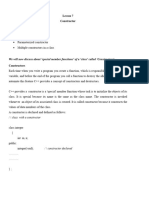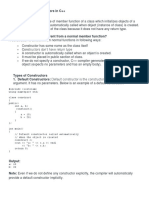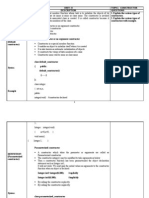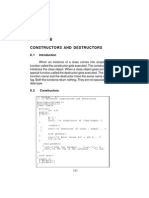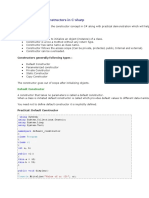Constructor and Destructors
Constructor and Destructors
Uploaded by
Sumanth RajCopyright:
Available Formats
Constructor and Destructors
Constructor and Destructors
Uploaded by
Sumanth RajOriginal Title
Copyright
Available Formats
Share this document
Did you find this document useful?
Is this content inappropriate?
Copyright:
Available Formats
Constructor and Destructors
Constructor and Destructors
Uploaded by
Sumanth RajCopyright:
Available Formats
Constructor and Destructors
Constructing Objects
Automatic initialization
Constructors
Parameterized constructors
Constructor overloading
Default constructor
Default argument Constructor
Dynamic constructor
Constructing matrix objects
Destructor
Introduction
C++ is to create user-defined data type as class behave very similar
to the built-in type
Able to initialize a class type variable(object) when it is declared
same as intialization of an ordinary variable
Ex: int m=20;
float x=79.8;
Are valid initialization statements for basic data types
When a varaible of built-in type goes out of scope, the compiler
automatically destroyed the variable.
C++ provides a special member function called Constructor which
enables an object to initialize itself when it is created known as
automatic initialization of objects
Destructor that destroys the objects when they are no longer
required
Constructors
1.A constructor is a Special member function whose task is to
initialize the objects of its class
2. It is special because its name is the same as the class name
3.The constructor is invoked whenever an object of its associated class
is created.
Called constructor because it constructs the value of data members
of the class
Syntax:
//class with a constructor
Class integer
{ int m,n;
public:
integer(void); //Constructor declared
..
};
Continues..
integer::integer(void)//constructor defined
{ m=0;n=0;
}
integer int1; //object int1 created
not only creates the object int1 of type integer but also initializes its
data members m and n to zero. There is no need to write any statement
to invoke the constructor function. If a normal member function is
defined for zero initialization, we would need to invoked this function for
each of the objects separately. This is very inconvenient ,if there are
a large number of objects
Default Constructor
A constructor that accepts no parameters is called the default
constructor
The default constructor class A is A::A().
If no such constructor is defined ,then the compiler supplies a default
constructor. such as
A a;
invokes the default constructor of the compiler to create the object a.
Constructor functions, special
characteristics
They should be declared in the public section
They are invoked automatically when the objects are created.
They do not have return types, not even void and therefore, they cannot
return values.
They cannot be inherited, through a derived class can call the base class
constructor.
Like other c++ functions, they can have default arguments
Constructors cannot be virtual
We cannot refer to their addresses.
An object with a constructor( or destructor) cannot be used as a member of
a union
They make implicit calls to the operators new and delete when memory
allocation is required
Note: When a constructor is declared for a class, initialization of the class
objects becomes mandatory
Parameterized Constructor
C++ permits us to achieve objective by passing arguments to the constructor function
when the objects are created. The constructors that can take arguments are called
Parameterized Constructors
The constructor integer() modified to take arguments
class integer
{ int m,n;
public :
integer(int x,int y);// parameterized constructor
};
integer::integer(int x,int y)
{ m=x;n=y;
}
When a constructor has been parameterized, integer int1; may not work
We must pass the initial values as arguments to the constructor function when an object
is declared.
Continues.
This can be done in two ways
1. By calling the constructor explicitly
2. By calling the constructor implicitly
First Method:
integer int1=integer(0,100);//explicit call
The above statement creates an integer object int1 and passes the
value 0 and 100 to it.
Second Method
integer int1(0,100);//implicit call (shorthand method)
//Simple program :Class with constructor
#include<iostream.h>
class integer
{ int m,n;
public:
//constructor declared
integer(int,int);
void display(void)
{ cout<<m=<<m<<endl;
cout<<n=<<n<<endl;
}
};
//constructor defined
integer:: integer(int x,int y)
{ m=x;n=y;
}
int main()
{//Constructor called implicitly
intege int1(0,100);
//Constructor called explicitly
Integer int2=integer(55,65);
cout<<\n object1=<<endl;
int1.display();
cout<<\n object2=<<endl;
int2.display();
return 0;
}
Output
Object1
m=0
n=100
Object2
m=55
n=65
Constructor functions defined
//inline functions
class integer
{int m,n;
public:
//inline constructor
integer(int x,int y)
{ m=x;y=n;
}
.
..
};
//Constructor can accept a
//reference to its own class as
// parameter
class A
{ .
.
public:
A(A&);
};
The parameter of a constructor can be of any type except that of the
class to which it belongs
class A
{
.
.
public:
A(A);
};
is illegal
Multiple Constructor in a class
Two kinds of constructor
integer();//no arguments
integer(int,int);//two arguments
C++ permits us to use both
constructor in the same class
class integer
{ int m,n;
public:
//constructor 1
integer(){m=0;n=0;}
//constructor 2
integer(int a,int b)
{ m=a;n=b;}
//constructor 3
integer(integer &i)
{m=i.m;n=i.n;}
};
invoke constructor
First method
//constructor receives no arguments
//set both m and n of i1 to zero
integer i1;
Second method
//constructor receives two arguments
//set m and n of i2 to 20 and 40
Integer i2(20,40);
Third method
//constructor copies the values of i2 to i3
//sets the value of every data element of
//i3 to the value of the corresponding
//data element of i2(copy constructor)
Integer i3(i2);
Note: When more than one constructor
function defined in a class, we say
constructor is overloaded
Overloaded constructors :add two complex numbers
#include<iostream.h>
class complex
{float x,y;
public:
complex(){ }
complex(float a){x=y=a;}
complex(float real,float imag)
{ x=real;y=imag;}
friend complex sum(complex,complex);
friend void show(complex);
};
complex sum(complex c1,complex c2)
{complex c3;
c3.x=c1.x+c2.x;
c3.y=c1.y+c2.y;
return (c3);
}
void show(complex c)
{ cout<<c.x<<+j<<c.y<<endl;}
int main()
{ complex A(2.7,3.5);
complex B(1.6);
complex C;
c=sum(A,B);
cout<<A=;show(A);
cout<<B=;show(B);
Cout<<C=;show(C);
//Another way to give initial values
//second method
complex P,Q,R;
P=complex(2.5,3.9);
Q=complex(1.6,2.5);
R=sum(P,Q);
cout<<endl;
cout<<P=;show(P);
cout<<Q=;show(Q);
cout<<R=;show(R);
return 0;
}
Output
A=2.7+J3.5 P=2.5+J3.9
B=1.6+J1.6 Q=1.6+J2.5
C=4.3+J5.1 R=4.1+J6.4
You might also like
- Lab - Weighted Composite Complexity Measure - AnswerDocument3 pagesLab - Weighted Composite Complexity Measure - Answerpwasana99No ratings yet
- Advanced C++ Interview Questions You'll Most Likely Be AskedFrom EverandAdvanced C++ Interview Questions You'll Most Likely Be AskedNo ratings yet
- Lecture 07Document11 pagesLecture 07Joash MacentonNo ratings yet
- CH 4Document20 pagesCH 4sparthsalunkeNo ratings yet
- ConstructorsDocument49 pagesConstructorsJyotika AggarwalNo ratings yet
- Constructors: Presented By: Er. Simarpreet Kaur Subject: Programming in C++Document23 pagesConstructors: Presented By: Er. Simarpreet Kaur Subject: Programming in C++Peace ReminderNo ratings yet
- Module 3 CPP NewDocument21 pagesModule 3 CPP NewA 18No ratings yet
- ConstructorsDocument18 pagesConstructorsshivani.gargNo ratings yet
- ConstructorsDocument28 pagesConstructorslakshaysaini05401No ratings yet
- C Unit-3Document12 pagesC Unit-3BHARATHI TNo ratings yet
- Unit-1.9 - Constructors and Destructors in C++Document9 pagesUnit-1.9 - Constructors and Destructors in C++Vedant AmonkarNo ratings yet
- ConstructorDocument31 pagesConstructorarpanabharaniNo ratings yet
- Module 1 C++edittedDocument24 pagesModule 1 C++edittedThendralNo ratings yet
- DAY: 1 Unit: Ii Topic: Constructor Concept Description QuestionsDocument21 pagesDAY: 1 Unit: Ii Topic: Constructor Concept Description QuestionsPratheep DeepuNo ratings yet
- Computer Science Chapter 5 Constructors and Destructors From Sumita AroraDocument22 pagesComputer Science Chapter 5 Constructors and Destructors From Sumita AroraKamal Joshi78% (9)
- 3rd ChapterDocument12 pages3rd Chapterjayashri dorikNo ratings yet
- Constructor and DestructorDocument14 pagesConstructor and DestructorAkash Singh SinghNo ratings yet
- 19-Constructors & Destructors, This Pointer-08-03-2024Document25 pages19-Constructors & Destructors, This Pointer-08-03-2024sundarrithwikNo ratings yet
- Constructor and DestructorDocument14 pagesConstructor and Destructormail.sushilk8403No ratings yet
- Const DestDocument29 pagesConst DestvaibhavNo ratings yet
- Unit II - Constructor&DestructorDocument6 pagesUnit II - Constructor&DestructorSaravana Kumar RNo ratings yet
- Object Constructor & DestructorDocument24 pagesObject Constructor & DestructorDeepak YadavNo ratings yet
- Unit 2Document21 pagesUnit 2shelkepravin8080No ratings yet
- ConstructorDocument7 pagesConstructortsafridi3No ratings yet
- DBMS Chapter 5Document20 pagesDBMS Chapter 5reddynanda426No ratings yet
- OOPs-Unit 3Document41 pagesOOPs-Unit 3Shashank Mani TripathiNo ratings yet
- Constructors in C++: What Is Constructor?Document7 pagesConstructors in C++: What Is Constructor?libranhitesh7889No ratings yet
- What Is A Constructor?Document15 pagesWhat Is A Constructor?Alone StrangerNo ratings yet
- Types of Constructor OOPS 6Document7 pagesTypes of Constructor OOPS 6raiarya3406No ratings yet
- Unit Iii Constructor and Operator OverloadingDocument21 pagesUnit Iii Constructor and Operator Overloadingamuthavalli.cseNo ratings yet
- Constructors in C++Document4 pagesConstructors in C++Pankaj BiswasNo ratings yet
- Constructors and Destructors: C++ 6 Sem, A' Div 2018-19 Prof. Mouna M. NaravaniDocument19 pagesConstructors and Destructors: C++ 6 Sem, A' Div 2018-19 Prof. Mouna M. NaravaniMohanNo ratings yet
- Chap 0205Document11 pagesChap 0205udyadav430No ratings yet
- Constructor and DestructorsDocument6 pagesConstructor and Destructorssh21222324252627No ratings yet
- Constructors and DestructorsDocument29 pagesConstructors and DestructorsVijeta ShuklaNo ratings yet
- Chapter08 C++Document10 pagesChapter08 C++dinu_caty3545No ratings yet
- Chapter 9-Constructors & Destructors (61-71)Document12 pagesChapter 9-Constructors & Destructors (61-71)Khushi Y.SNo ratings yet
- Constructors and DestructorsDocument74 pagesConstructors and DestructorsAditya KavuluriNo ratings yet
- Anna University OOPS Question Bank Unit 2Document6 pagesAnna University OOPS Question Bank Unit 2Karthic SundaramNo ratings yet
- Constructors & Destructors in C++Document13 pagesConstructors & Destructors in C++spdgupta0No ratings yet
- Unit 2function OverloadingDocument14 pagesUnit 2function Overloadingchargedparticle07No ratings yet
- Oop Mod3@Azdocuments - inDocument60 pagesOop Mod3@Azdocuments - inShankar MNo ratings yet
- Constructors & DestructorsDocument32 pagesConstructors & DestructorsAbootlhaNo ratings yet
- ConstructorDocument4 pagesConstructorSanjib DebnathNo ratings yet
- L4 L5Constructors and Destructors 02-08-2017Document40 pagesL4 L5Constructors and Destructors 02-08-2017vipin sainiNo ratings yet
- Unit 3: Constructors and DestructorsDocument32 pagesUnit 3: Constructors and DestructorsJunaid ShaikhNo ratings yet
- Constructor, Operator OverloadingDocument23 pagesConstructor, Operator OverloadingJPR EEENo ratings yet
- 03-Constructors and Destructors (Revised)Document38 pages03-Constructors and Destructors (Revised)Arif IstiaqNo ratings yet
- Industrial Training FileDocument29 pagesIndustrial Training Fileprashantpanchal0916No ratings yet
- Chapter 9 ConstructorsDocument13 pagesChapter 9 ConstructorsTheking100% (1)
- Constructors destructorsDocument7 pagesConstructors destructorsgame43250No ratings yet
- Oops FileDocument14 pagesOops Fileshaangaming798No ratings yet
- Constructor and DestructorDocument17 pagesConstructor and Destructorramesh veeraragavanNo ratings yet
- Chapter 9 ConstructorsDocument14 pagesChapter 9 Constructorsrockstargaming9088No ratings yet
- Object Oriented Programming Lab 8-1Document13 pagesObject Oriented Programming Lab 8-1Haristic 01No ratings yet
- Constructors in C #Document36 pagesConstructors in C #Awanish Ramesh TripathiNo ratings yet
- WINSEM2023-24 BCSE102L TH VL2023240501147 2024-02-23 Reference-Material-IIIDocument15 pagesWINSEM2023-24 BCSE102L TH VL2023240501147 2024-02-23 Reference-Material-IIIShri ABCDNo ratings yet
- C Classes PDFDocument20 pagesC Classes PDFPradeep AgarwalNo ratings yet
- Introduction to Python Programming: Do your first steps into programming with pythonFrom EverandIntroduction to Python Programming: Do your first steps into programming with pythonNo ratings yet
- C++ Game of Life Header FileDocument1 pageC++ Game of Life Header FileKurt NguyenNo ratings yet
- Java VKDocument130 pagesJava VKHSKALRANo ratings yet
- Pseudocode Cheat Sheet A4Document6 pagesPseudocode Cheat Sheet A4joe bloggsNo ratings yet
- "Java Objects and Classes": Presented By: Rodgen C. Gamalo BSIT-3 StudentDocument10 pages"Java Objects and Classes": Presented By: Rodgen C. Gamalo BSIT-3 StudentXian Manny MaraonNo ratings yet
- Ics 2104 Object Oriented Programming IDocument3 pagesIcs 2104 Object Oriented Programming ImyutestnotificationNo ratings yet
- Chapter 7 - StructuresDocument5 pagesChapter 7 - Structuress1116035No ratings yet
- System Verilog Object Oriented Programming and ClassesDocument48 pagesSystem Verilog Object Oriented Programming and ClassesSinchana GuptaNo ratings yet
- Module 3 InterfacePakagesExceptionDocument29 pagesModule 3 InterfacePakagesExceptionVijay VNo ratings yet
- Type Erasure - A Design Analysis9268Document73 pagesType Erasure - A Design Analysis9268Diego GomezNo ratings yet
- PROGRAM 1: Write A Program To Check Whether A Given Number Is Even or OddDocument45 pagesPROGRAM 1: Write A Program To Check Whether A Given Number Is Even or OddShobhita MahajanNo ratings yet
- C++ - Object Oriented ProgrammingDocument179 pagesC++ - Object Oriented ProgrammingCache Line100% (1)
- M.1 - Intro To Smart Pointers and Move Semantics - Learn C++Document29 pagesM.1 - Intro To Smart Pointers and Move Semantics - Learn C++njb25bcnqfNo ratings yet
- Distributed System Lab ManualDocument12 pagesDistributed System Lab Manualabinashshrestha845No ratings yet
- Unit 2 - Object Oriented Programming and Methodology - WWW - Rgpvnotes.inDocument13 pagesUnit 2 - Object Oriented Programming and Methodology - WWW - Rgpvnotes.inAyk AykNo ratings yet
- Java Lab Practical 7Document3 pagesJava Lab Practical 7Sahil KumarNo ratings yet
- 1) Explain The Arithmetic, Relational and Logical Operators With Suitable ExampleDocument14 pages1) Explain The Arithmetic, Relational and Logical Operators With Suitable Examplesureshfm1No ratings yet
- Lab Sheet 1 OopsDocument5 pagesLab Sheet 1 OopsMVK CR7No ratings yet
- ClassificationDocument7 pagesClassificationRAROSS KAMILLAH RASITNo ratings yet
- CE - 144 OOPC++ Practical ListDocument13 pagesCE - 144 OOPC++ Practical ListMalav PatelNo ratings yet
- C# Case ExampleDocument3 pagesC# Case ExampleLita AbigailNo ratings yet
- Welcome To Java Programming Course at Seed: SEED Infotech Pvt. LTDDocument36 pagesWelcome To Java Programming Course at Seed: SEED Infotech Pvt. LTDAnonymous FKWVgNnSjoNo ratings yet
- Developing A CORBA ServerDocument59 pagesDeveloping A CORBA Serversatheesh4590No ratings yet
- 2.1 Introduction To Object Oriented Data Bases Object DatabasesDocument27 pages2.1 Introduction To Object Oriented Data Bases Object DatabasesSekar KsrNo ratings yet
- Swt301 Sp24 Pe TemplateDocument6 pagesSwt301 Sp24 Pe Templateuyennlda170024No ratings yet
- SanjanaDocument7 pagesSanjanaringtonechannel123No ratings yet
- JAVA Unit Wise Imp QuestionsDocument3 pagesJAVA Unit Wise Imp QuestionsDivya0% (1)
- Report Lab 2.1Document8 pagesReport Lab 2.1deaNo ratings yet
- Group Activity Experiment: Public Class Public Int ThisDocument5 pagesGroup Activity Experiment: Public Class Public Int ThisAldrin MndzNo ratings yet
- 21csc101t Oodp Unit-2Document43 pages21csc101t Oodp Unit-2sreeramvrkumarNo ratings yet



